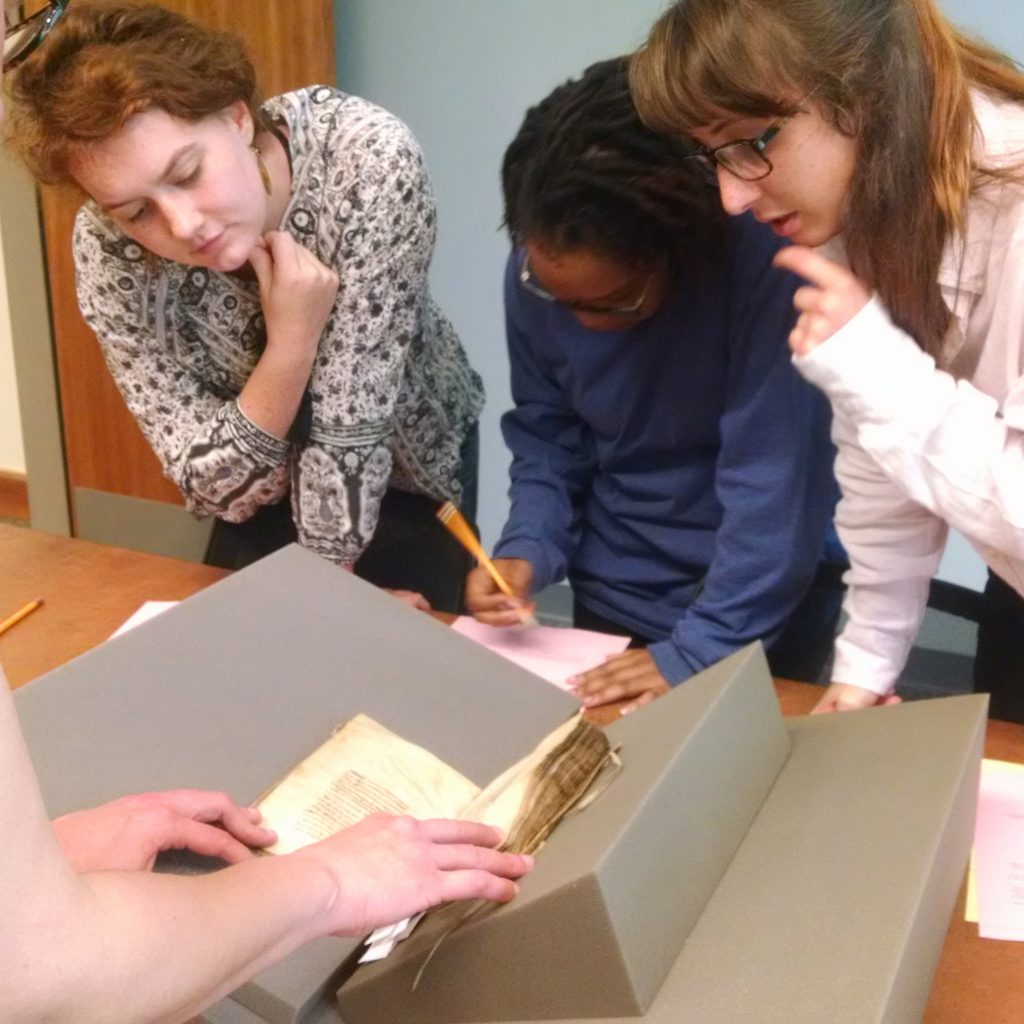
This week, we’ve begun the Hargrett Hours project for real. Or, to be more precise, we’ve geared up this week with preliminary work and organizing. Tuesday, the students got to visit the Hargrett Hours for the first time; Wednesday, they learned what research groups they’ll be in for the rest of the semester; Thursday we had a library tutorial and an organizational session, so that everyone can hit the ground running next Monday.
Let me use this blog post to break down the organization of the students for the unit. I want to lay out my prep here in case others are looking for ways to get an entire class of students to study one manuscript. The whole thing only works, however, because the Special Collections libraries had already made a PDF facsimile of the manuscript many years ago, so the student teams can work primarily off that facsimile. If you had 20 students all needing to use a single, physical manuscript, that might be a logistical problem.
The Hargrett Hours divides neatly into 5 sections — the calendar, the Hours of the Virgin, scriptural passages, miscellaneous prayers, and suffrages — so I assigned teams of 4 students to four sections of the manuscript (combining scriptural passages and prayers into a single section). A fifth team is tackling the manuscript’s physical description and collation. Other elements that need to be studied, especially its provenance and decoration, are being held in reserve, for later in the semester or next year.
In short, the students will work in their groups to transcribe their section, identify the saints and/or prayers in question, and begin to ask questions about their findings (who is St Nicholas? is this mass prayer common or rare? why is Genevieve in both the calendar and the suffrages?) so we can begin to assess where this manuscript falls in the landscape of later medieval Books of Hours. I’ve devised step-by-step instructions to help each team get started, including “do X before Y” and “how to search what” tricks. The students are understandably trepidatious about leaping into a research project of this magnitude, so I have tried to map out process for them so they can focus on accomplishing bite-sized tasks, one at a time.
In addition to working within their groups, students will also be sharing information across groups. One member each from the Calendar and Hours of the Virgin teams, for instance, will pair up to determine the manuscript’s use. The Calendar and Suffrages teams will collaborate on researching shared saints. And everyone will let Team Codicology know when they discover or suspect they are missing leaves or even whole quires, and vice-versa.
Logistical nightmare, sharing all this information? Maybe, but I hope not. We’re experimenting with different methods of sharing documents (hooray Google Docs!) and coordinating our research efforts – perhaps more on that in another post. Undoubtedly there will be hiccups, and I’m prepared for that.
What are our goals for the rest of the semester? It’s hard to know how quickly or slowly each team will work, so I haven’t set numerical benchmarks. What I do require is that each team establish a firm foundation for the next class to build on: accurate transcriptions of texts; a full codicological description, with concrete questions about excisions and binding changes for the next class to pursue; reasonable hypotheses about the manuscript’s liturgical use; and a solid body of data about the prayers and saints in the manuscript.
What are our outputs? Instead of writing ye olde English class essays, each group will co-author a report that will be read by the next Hargrett Hours class. The goal of the report is to lay out the process by which the students undertook their research, the discoveries they made, the pitfalls they discovered, and the hypotheses they formed so that the next class can pick up where this one left off and build upon their findings. Anticipate interim reports here on the blog before Thanksgiving; I anticipate the early discoveries will fly thick and fast once the students delve into the manuscript. They will also collate their transcriptions, manuscript description, and research conclusions; this raw data will find its way into the digital output we will devise in a few semesters.
It’s exciting, and daunting, to leap into such an ambitious project. It’s even more exciting because I’m doing it with a team of intelligent, energized, and curious students. So here we go — game on!